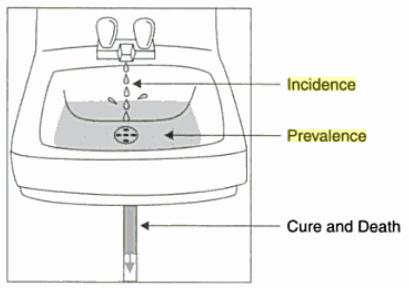Measuring health and illness
Measures of Disease Frequency: Common Rates in Epidemiology
![]() The most commonly used rates in epidemiology to evaluate morbidity are incidence and prevalence. These describe the frequency of disease during a given time period. Mortality rate, also a commonly used epidemiological rate, is a rate used to measure deaths and not morbidity.
The most commonly used rates in epidemiology to evaluate morbidity are incidence and prevalence. These describe the frequency of disease during a given time period. Mortality rate, also a commonly used epidemiological rate, is a rate used to measure deaths and not morbidity.
1. Incidence Rate
Total # new cases of specific disease during time period
Total population at risk during time period
This is the primary outcome of experimental and cohort studies. This is what it is needed for the investigation of causal inference.
2. Prevalence Rate
Total # new AND pre-existing cases of specific disease during time period
Total population at risk during time period
This is the primary outcome of cross-sectional studies. There can be two types of prevalence: 1) the point prevalence for the estimates at a specific time, or 2) period prevalence for the estimates within a range of time.
Figure 1. Comparison of Incidence and Prevalence

Figure from: Ann Aschengrau & George R. Seage, Essentials of epidemiology in public health.
Notes: Prevalence is like the water collecting in the basin that has all of the cases in the population. Incidence is the water dripping from the faucet, which are the new cases. Death and cures are the output flow from the basin.
3. Mortality Rate
This measure describes the incidence of death/total population at a given time. Typically reported in 3 ways:
i. Crude: One overall rate; no adjustment for other factors. Insert actual (observed) mortality and population values into numerator & denominator
ii. Cause-Specific or Group-Specific: Relevant to particular population characteristics (e.g., specific age group, gender, ethnicity, cause of mortality). Example: infant mortality rate
iii. Adjusted: Rate that has been recalculated to adjust for difference in some population characteristic between sample and overall population or between 2 different samples. Example: age-adjusted mortality rate because sample has disproportionate number of old or young people.